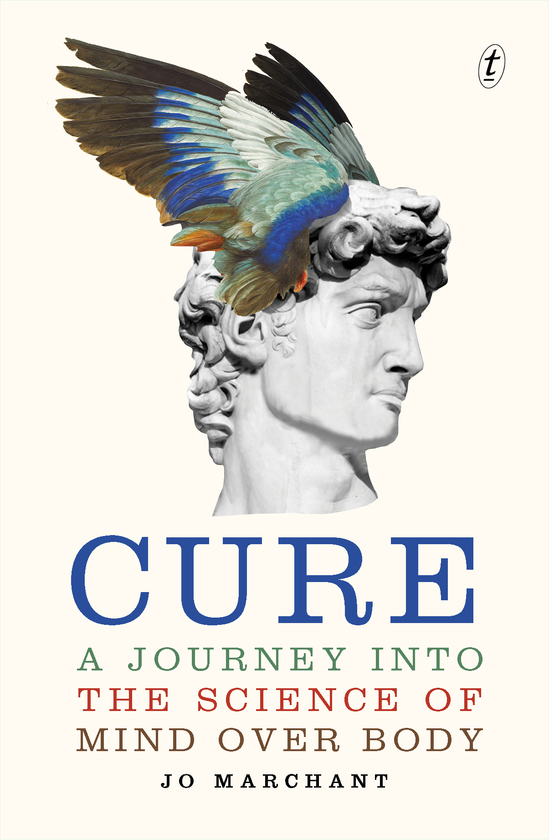 Reviewed by Magdalena Ball
Reviewed by Magdalena Ball
Cure:
A Journey Into the Science of Mind Over Body
By Jo Marchant
Text Publishing
368pp, Paperback, 27 January 2016, ISBN: 9781922147721, $A32.99
As someone who works in a science related profession, I’m used to the placebos being synonymous with inert or inactive. It’s always the control in a double-blind trial. However, as the child of a homeopathist who has genuinely helped many people solely by listening carefully to them, and then providing them with bottles of tiny, entirely inert (‘diluted’) sugar pills, I’ve seen first hand how powerful the mind can be in its impact on human health. Jo Marchant’s book explores the power of the mind in a very clear-sighted scientific way that is both sensitive and rigorous. Though there’s nothing in this book that is hard to swallow or accept, and the evidence Marchant presents is probably something that most people will have at least some experience of, I nevertheless found Cure to be mind-blowing. The book is written in very clean, simple English, and with a perfect balance between anecdotal stories and scientific evidence. Marchant strives very carefully to keep this balance, to qualify and where possible, quantify everything she states. She is always careful to ensure that there are clear explanations for why and how the alternative treatments that are explored work.
The book is structured into twelve chapters that take the reader on Marchant’s extensive tour of a range of placebo based trials around the world where doctors and patients who are seeing powerful results (thereby perhaps changing the whole meaning of the word “placebo”) on some previously intractable conditions. It’s not just the “power of positive thinking”, but actual real chemicals such as endorphins, dopamines, and hormones being released in response to a number of different stimulations. These chemicals can heal, they can impact on pain, and they can have a dramatic effect on the immune system:
The really new idea, here, though, is that when it comes to health, our minds determine far more than our subjective experience of the physical world around us. Through changes in gene expression, for example, and in the way our brains are wired, the way in which we see the world helps to shape our bodies too. We play a role, then, in constructing not just our experience but our physical reality. And in turn, the health of our physical bodies influences the state of our minds. (299)
Marchant explores a wide number of placebo trials from fake surgery, Pavlovian reponses, pretend pills, the use of smells, hypnosis, the use of video games to distract burns patients from the pain of their treatment, the use of fake oxygen, the power of the breath, visualisation, meditation, empathy, social support/networks, and even religion. Marchant even did a stint of volunteer work at Lourdes as part of her research. Some of what Marchant explores is pretty mainstream already. Meditation/mindfulness and cognitive behavioural therapy (CBT) are used extensively by psychologists, though rarely by other types of medical practitioners (Oncologists for example). Other treatments, such as the virtual reality “snow world” for pain relief and the use of hypnotherapy to cure irritable bowel syndrome are still somewhat cutting edge. Marchant peppers her observations and research with personal anecdotes and stories, including her own experiences in labour, something that certainly aligns with my own experiences.
One of the many issues that Marchant points out is how hard it has been for placebo researchers to get funding (partly because most funding is done by drug companies and they have a vested interest in not researching the value of a placebo), and how deep the need for a holistic approach to healing. Despite the great value we’ve derived from advances in chemical treatments, our over-reliance on pills, especially antibiotics and painkillers, has taken the medical profession to the limits of what it can achieve in a number of areas, including research on such things as end of life care, childbirth, auto-immune conditions, chronic fatigue, and the impact of stress across the board. Placebos can often solve problems that drugs cannot, and the need for more pilots, better ways of delivering these solutions, and more holistically trained doctors is critical:
The ingrained resistence to mind-body interventions is something I’ve heard about over and over again while researching this book. Even when scientists have funding, they often have to find the surrounding culture in hospitals and universities just to conduct a trial. (295)
Above all, the value of Cure, I think, is that it unravels false dichotomies – between alternative and mainstream medicine, and between mind and body. Cure is a rational book written by a scientist and uses a very tight scientific process to explore the notion of the mind’s power to heal itself:
I’m not advocating relying solely on the mind to heal us; but denying its role in medicine surely isn’t the answer either. My hope, then, is that this book might help to overcome some of the prejudice against mind-body approaches, and to raise awareness that taking account of the mind in health is actually a more scientific and evidence-based approach than relying ever more heavily on physical interventions and drugs. (297)
Cure contains many recommendations on how the scientific community can embrace existing work, and do further studies on how to apply the power of the mind to help heal, reduce pain, and support other forms of chemical treatment. The book also provides practical suggestions for the reader to apply these tools to their own life. Above all, it changes the way we think about the interaction between the mind and the body and instead presents a far more holistic perspective in which healing and wellness is the aim and the pathways to that aim can be many and varied.